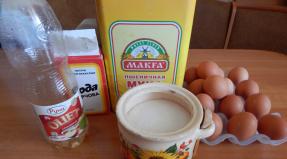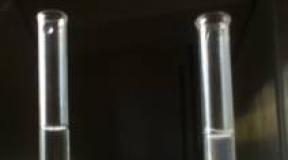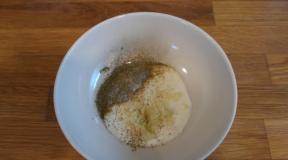Standards ppm in exhaled air. Permissible rate per mille for drivers in Russia
Alcohol intoxication is one of the most frequent causes of accidents in Russia, so every driver should know what the permissible rate of alcohol in the exhaled air and in the blood of the person driving a car is set in 2018-2019.
Why do we say that there is an acceptable minimum threshold, if we know the “golden rule” - planning to get behind the wheel, do not use a gram of alcohol! It's simple - 0.16 mg / l is the standard error of the devices used today by traffic police officers of Russia. When recalculating the blood alcohol content, we just get the index 0.35 ppm.
Car and alcohol
The concept of "permissible amount of drunk alcohol" does not exist!
Each organism is individual and responds to products that contain alcohol in its own way. For someone, 50 grams or less is enough for the appearance of the familiar feeling of light vertigo. But, even the absence of obvious symptoms does not mean that a person is sober.
Inhibition of reactions of the central nervous system and dullness of attention under the influence of small doses of alcohol occurs much earlier than the apparent symptoms of intoxication.
That is why never be guided by the correspondence tables laid out in the network, claiming that the breathalyzer will not feel if you drink 40 grams of vodka or 300 grams of beer. Moreover, this condition can occur not only when drinking alcohol, but also when ingested a number of other substances used in pharmacology and medicine.
Therefore, it is important for every novice motorist to know in which case serious troubles await him, how to avoid them, and, most importantly, how to act when an accusation has already been brought.

Standards and methods of control
Officially, in 2018-2019, the permissible rate of alcohol in the exhaled air or in the blood is checked.
Option 1 - the driver is tested for the presence of alcohol in the body with the help of a breathalyzer (a special device that determines the percentage of alcohol vapor in the exhaled air).
Option 2 - The driver is offered to take a blood test (from a vein) in the nearest medical facility. As a rule, blood is taken for analysis in cases where the driver is not physically able to pass the test described in the first embodiment.
To date, the minimum threshold is set at:

Inspection Procedure
Important! Refusal to undergo the procedure of alcohol testing in accordance with the norm of the law is equivalent to the fact that you are in a state of intoxication.
Now you know what the permissible rate of alcohol in the blood is established for drivers of all vehicles in 2018-2019, and what it depends on. Therefore, the first thing that needs to be done if DPS officers require passing the test is:
- specify the error of the device used;
- find out when he was officially trusted;
- require the procedure to be recorded on video;
- require the presence of 2 witnesses (DPS officers can not play the role of witnesses).
Moreover, the driver has the right to see that the tip for the device is disposable and new. Ideally, the DPS officer should not touch the unpacked tip of the breathalyzer.
A 0.16 ppm result means the driver is sober!
The site Kolesa.ru has a great reminder for the driver, following which you will not get into a difficult situation.

If, despite your complete confidence in your sobriety, the device showed more than 0.16 ppm, the main thing is not to sign an agreement with the results, describe your disagreement on paper in detail and go as soon as possible to the nearest medical facility where you can be examined. A blood test will have more weight during the trial.
Did not drink, but drunk
Among the drivers there are a lot of different stories about how the breathalyzer showed more than 0.16 ppm, although the person didn’t touch the alcohol that day. Is it possible?
Experts who have studied this issue unanimously declare that exceeding the norm can produce a variety of products:
- any alcohol-based drugs (most often cough syrups, soothing and heart);
- fermentation products, such as kvass, kefir, koumiss, etc .;
- mouthwashes;
- coffee additives (before pouring them into the cup, you should make sure that the additive is non-alcoholic);
- very ripe bananas and oranges;
- black bread;
- some high carbohydrate desserts can also have this effect on a number of people.
But, this is all very individual. We offer to watch one of the videos in which it is tested whether the permissible rate of alcohol in the exhaled air is exceeded after consuming a number of the products listed above, and also explains why in 2018-2019 they will believe more in the driver’s ppm blood.
Punishment
Regardless of what caused the increased rates (especially if confirmed by a blood test), the driver, as well as the owner of the car who transferred control to the person in a drunken state, are responsible:

Reasoning on the topic of how much milder the driver is allowed in the blood in 2018 and 2019, few people think that this letter of the law is the result of numerous accidents that have claimed many lives.
Of course, it’s unpleasant if you are accused of being in a drunken state when you stop at a traffic police station, but everything is much more serious if an accident occurs due to a drunk driver. There are completely different articles of the Criminal Code of the Russian Federation and the punishment may be much more serious, namely:
Also, the culprit will be obliged to compensate the material damage to all those who suffered as a result of his actions.

Restoration of rights
It is still possible to regain the right to drive a vehicle after the court finds guilty under this article.
Upon expiration of the deprivation of rights, the convicted person must:
- retake the theoretical part in the traffic police;
- eliminate debt fines.
We also suggest listening to the advice of lawyers who will tell you how to behave if you are stopped at a traffic police station and what to do if the breathalyzer gave a positive result:
The permissible rate of alcohol driving in ppm 2017, the law 0.16. How to avoid exceeding the norm, what it threatens and what affects the indicators of alcohol content.
Alcohol affects the human brain. To reduce the number of deaths on the roads due to the fault of drunk drivers, adopted a law on "zero ppm."
But due to the inaccuracy of breathalyzers and the physiological characteristics of the organism, in 2013, the indicator increased from zero per mille to 0.16 in exhaled air and 0.35 in blood. These rules apply to drivers of all motor vehicles, including mopeds and scooters.
What is ppm?
Promille - one thousandth of something. Percentage - one hundredth. The phrase “blood alcohol content is 0.2 ppm” means that 0.02% of the blood taken is alcohol. This is 0.09 mg per 1 liter of blood.
The same applies to exhaled air. Breathalyzer measures the volume of gas and how much alcohol vapors form in it, and expresses the value in ppm.
The higher this value, the more ethyl alcohol is ingested in humans, the stronger the consequences. For driving, the effect of ethanol on the brain is important. Driving while taking alcohol is dangerous.
- Critical thinking decreases.
A person gets the illusion that he controls the situation even better than sober. This is a self-deception, because alcohol, if its amount is above the physiological norm, affects the brain. - Eyes see and distinguish objects worse.
- The processes of exchange between the brain are slowed down.
The feeling that you think clearly and clearly, but in reality the speed of thinking decreases. The signal from the receptors (eyes, ears, skin) to the cerebral cortex and back goes longer.
And if in a sober state it takes a split second to trigger the reflex, then alcohol increases this time. That is why, a huge part of the accidents happens because of drunk drivers and the permissible rate of alcohol at the wheel is set in ppm.
They just do not have time to lay down the situation in the head. If a sober person would slow down a second earlier, then a drunk can’t do it physically. - The ability to estimate the distance to objects, especially moving ones, is deteriorating.
- The nervous system reacts by slowing down the processes, or, conversely, by excessive agitation and increased aggression.
Both that and other variant influences a manner of driving.
Permissible rate of alcohol driving in ppm 2017, law: 0.16
Initially, the adopted law was the figure 0. But ethanol also produces the human body itself, with some diseases the proportion of alcohol in the exhaled air or in the blood may be higher.
This feature does not affect the ability to soberly think and assess the road situation. Fail and gauges. Therefore, we decided to increase the value for the breathalyzer to 0.16.

The permissible rate of alcohol driving in ppm 2016 is identical to 2015 and 2017.
If the breathalyzer recorded the amount of alcohol 0,17 and more, then according to the law you are waiting for problems:
- A fine of 30 000 rubles and deprivation of rights for 1.5 - 2 years (by court decision). This penalty applies if:
- Breaking for the first time.
- You put behind the wheel of your vehicle a person who has found alcohol in the blood or exhaled air.
- You refuse to undergo a medical examination.
- A fine of 50,000 rubles and deprivation of rights to 3 years, if you have already been fined for the same violation, but the term of the previous sentence is over.
- Administrative arrest for 10-15 days, if you are deprived of rights due to violations not related to alcohol and refuse to undergo a medical examination.
- A fine of 200 - 300 thousand rubles, or in the amount of annual income - if you got drunk behind the wheel, when you were already deprived of the rights to detect alcohol. The court may also prohibit you from occupying certain positions, discharging forced labor, or even imprisonment for up to 2–3 years.
What affects the blood alcohol content
If you took alcohol the day before, the next morning, residues that are above the norm can be found in the blood and exhaled air.
Removal of alcohol from the body depends on age, sex, weight, general health, the amount of alcohol consumed, the state of the liver and kidneys. To find out whether you can get behind the wheel, buy a household breathalyzer.
True, if it is not of high quality, or if the batteries are exhausted or the service life is out, the results will differ from the professional ones used by the inspectors.
There is a list of products that briefly increase the amount of alcohol in the blood. If you breathe in the breathalyzer immediately after or within 5-10 minutes after their use, it will record the excess of the permissible rate:
- Drinks: non-alcoholic beer, kvass, koumiss, juice that was not in the fridge, stale warm berry compote.
Contrary to the legend prevalent among drivers, a glass of fresh kefir does not show excess alcohol. - Fruits: ripe berries, fermented jam, bananas, oranges.
- Products: black bread with sausage, chocolates with and without alcohol.
- Medicines: alcohol tinctures such as Corvalol, motherwort, valocardine, etc.
- Other: mouth freshener spray, Halls sucking mints.
The permissible rate of alcohol driving in ppm 2017 is the law of 0.16. If you have eaten or drank something from the list above, then most likely you will be able to return to normal. In any case, in 20-30 minutes the breathalyzer will show 0.
Therefore, if you are sure you are right, you insist on conducting a re-examination after a while. Also confirm that you did not drink alcohol, can a medical examination.
How is the medical examination
If you are sure that you did not drink alcoholic beverages, and the breathalyzer shows an excess of the norm, ask for a medical examination.
Inspectors can insist on this if they see external signs of intoxication, while the instruments show the norm. In this case, your refusal will mean a confession of guilt and will entail punishment.
Listen carefully to what the inspector says, and read what you are signing. You can refuse to be examined by traffic police officers, but you cannot refuse from medical.

Some inspectors specifically confuse drivers who are under stress from an unpleasant situation, and “fine” and fine.
If you have heard or seen the word "medical", in any case, do not refuse. Ask for clarification and clarification of what is meant.
Important points to remember:
- Removal from driving is made in the presence of two witnesses or with video recording.
- You must indicate in the protocol that you do not agree with the testimony of the device.
It is very important for further proceedings in court, if such suddenly arise. - For referral to a medical examination, two witnesses are called, who will sign a protocol.
- Inspectors must take you to a medical facility, and if intoxication is not detected, then bring back to the car.
- Refusal of any of the stages of the procedure (checking by an Alcotester already in a medical institution, donating urine or blood) is equivalent to refusing to be examined.
The permissible rate of alcohol driving in ppm 2017, the law - 0.16. If, on arrival at the medical center, the breathalyzer shows a lower value, then these readings will be recorded in the protocol, the inspector will take you back.
In any case, you will be required to pass urine for analysis. It takes place in the toilet, which always stands next to the mobile station honey. survey.
Doctors have to check urine temperature and ph values. If it is determined that this is someone else's analysis or it is diluted with water, this will be equated to failure.
If you collect enough for analysis failed within 30 minutes, then take a blood test.
An important point: when treating the skin, physicians are obliged to use an alcohol-free solution! The tubes are sent to the laboratory, in 10-13 days the answer will come. Up to this point, driving is prohibited.
The adoption of the law on “zero ppm” lowered the number of accidents with drunk drivers. Statistics for 2016 says that in total 13,100 people died due to the fault of the drivers of passenger cars.
Of this amount, 3789 died through the fault of drivers who were intoxicated. This is 17% more than in 2015, although the total number of “alcoholic” accidents decreased by 1%. The problem is very acute and does not seem to be solved by severe fines and penalties.
The fight against drunk drivers in our country is not the first year, consistently and uncompromisingly. Nevertheless, road accidents due to the fault of drunk drivers still lead in the official statistics of the State Traffic Safety Inspectorate of the Ministry of Internal Affairs, and the number of human victims grows like in a war. Any citizen of the Russian Federation will agree that drunkenness and driving can and should be fought mercilessly. Not everything works out at once, the legislation, the judicial procedure and the technical equipment changed, but one thing is certain that the state and society are not going to put up with such a situation on the roads, which means that the repressive machine will work at full speed. In order to ignore unknowingly under the judicial press and lose the license to drive a car, consider what constitutes the permissible rate of alcohol behind the wheel in ppm.
What is ppm?
The quantitative content of alcoholic alcohols in the human body can be accurately determined in two ways:
- the analysis of air vapor from the lungs by the breathalyzer;
- blood test in a medical laboratory.
Promille is a quantitative parameter of the content of ethyl alcohol in a liquid medium (human blood), which quite accurately determines the stage of intoxication.
Simply put, ppm shows how many milligrams of alcohol is 100 milliliters of blood. Indication in the breathalyzer - a device for measuring the degree of sobriety, the figures in 0.1 ppm means the quantitative content in one liter of human blood is 0.045 milligrams of ethyl alcohol.
This value is the basis for modern methods of determining the amount of alcohol in the body - the higher the numbers in ppm, the stronger the intoxication of the test driver. This is the way the modern police breathalyzers, analyzing the concentration of alcohol vapors with full expiration, are graded.
What caused the permissible rate of alcohol at the wheel
More than two and a half years ago, in our country, the article on the “zero” norm was terminated, when the alcohol content in human breathing could not exceed zero. The main reason for the cancellation was the inconsistency between the zero alcohol indicator and the physiological state of a normal human body and the value of the permissible error of the analyzers.
As it turned out, the minimum alcohol content in the body can be caused by taking medicinal alcohol-containing drugs (valocordin, Corvalol or motherwort tincture), drinking beverages containing fermented products (kvass or kefir), certain diseases and many other factors, and not alcohol abuse before the trip. In addition, police breathalyzers used by the traffic police of the Ministry of Internal Affairs for the analysis of drivers' breathing have a valid passport error of 0.05 per mil.
It should be remembered that each person is an individual in the physiological plan and there are no general rules for the time of the splitting of ethyl alcohol, for example. Established in the course of medical research have a very approximate value, represent the most general conclusions and are extremely dependent on many factors, such as gender, weight, metabolic rate, the functioning of internal organs. What will be the permissible rate of alcohol driving in ppm in 2016?
Allowable alcohol in driving in ppm 2016
According to the data currently available, the State Duma of the Russian Federation does not plan to make legislative changes to the Administrative Code in terms of increasing or decreasing the marginal rate of the content of alcohol vapors during pulmonary expiration.
As in previous years, the permissible rate of alcohol at the wheel in 2016 will not exceed the value of 0.16 ppm when analyzing expiration from the lungs and 0.35 ppm during laboratory blood donation.
In other words, the testimony on the display of the alcohol tester with a full expiration should not exceed 0.16 ppm. In case of exceeding of this standard established by the law of the Russian Federation, the driver will have to be responsible for drunk driving to the judicial authorities.

Penalties for exceeding the allowed rate
Any changes in the judicial legislation on the punishment of drivers who exceed the permissible rate of alcohol at the wheel of a car in 2016, apparently, is not expected.
As before, the maximum period for which the temporary confiscation of a driver's license is possible is no more than three years. The size of the fines imposed on violators for drunk driving is not increased at the moment:
- As before, when the traffic police officers first drunk the traffic offender in a drunken state, a fine of 30,000 rubles is issued and a court decision is issued to seize the driver’s personal certificate for a period of one and a half to two years.
- Refusal to donate blood for analysis at a medical institution will cost a drunken offender 30,000 rubles in the form of a fine and temporary confiscation of the rights to drive a car with a maximum period of up to 2 years.
- The same punishment (30,000 rubles and up to 2 years of deprivation of an ASU) is incurred by the owner of a car of any type, allowing the driving of a personal vehicle to a drunk person when the latter exceeds the permissible rate of alcohol at the wheel.
- In case of repeated detection of exceeding the marginal rate of 0.16 per mille or refusal of a medical examination, administrative responsibility is provided in the form of a fine of 30,000 rubles and an arrest for 10-15 days with deprivation of a VU for up to 3 years or criminal liability in the form of a fine from 200,000 to 300,000 rubles , compulsory work or imprisonment up to 2 years and the withdrawal of a driver's license for up to 3 years.
A violation will be repeated if it is committed within ONE year from the moment of the first arrest. If more than one year has passed since the first offense, then only administrative punishment can be applied.

Recommendations for the elimination of problems with the traffic police inspector
If on the eve of the trip the driver for some reason still had to drink alcohol, you need to follow the following rules:
- the longer the period between drinking and driving, the better;
- try to refrain from taking drugs before the road;
- Do not use kvass, kefir, sour milk, juice before a trip;
- do not use chewing gum and mouth rinse on the road;
- no need to try to trick the breathalyzer;
- Do not conflict with the traffic police inspector.
For the speedy elimination of toxins and alcohol residues, a contrast shower, a hot bath and a good night’s sleep help a lot. A healthy hot meal and a long walk in the fresh air have a positive effect.
Obviously, the punishment for drunk driving will only be tougher. The number of accidents in our country, unfortunately, is directly related to the increase in the alcohol content in the blood and does not need any other evidence. Do not risk your driver's license and hope for the traditional Russian "maybe" - it is much better to completely eliminate drunk driving. And it is good for health, and will allow to avoid big problems.
Video: Allowable alcohol driving
In Russia, the legal regulations governing the maximum permitted alcohol content in the body of drivers have changed several times. From 2010 to 2013, the law in our country was the so-called “zero ppm” law, according to which absolutely no dose of alcohol could be contained in the driver’s blood / exhaled air. However, due to the low efficiency, the operation of this law in 2013 was canceled. The fact is that a small amount of alcohol may be present in the driver’s body, but not because he took alcoholic beverages, but because of physiological characteristics, the use of certain foods or medical preparations.
In order not to impose administrative liability and fines on innocent drivers, the government revised the permissible dose per person for people who are driving a vehicle.
How many ppm can be contained in the driver's blood in 2019?
According to the Administrative Code, if the breathalyzer determines that the concentration of alcohol vapors exceeds the norm of 0.16 mg per liter of exhaled air, administrative responsibility is imposed on the driver. From this it follows that the maximum permissible alcohol content in exhaled air in 2019 is 0.16 mg / l.
Ppm value
Promille is the value that determines the degree of intoxication. This value is calculated by the level of alcohol in the blood.
Many drivers believe that 1 mg / l is 1 ppm, but this opinion is fundamentally wrong. For self-recalculation of mg / l in ppm, you must use the following formula:
0.1 ppm = 0.045 mg / l
Accordingly, in the process of calculating according to this formula, it turns out that for drivers in 2019 approximately 0.35 ppm is permissible.
However, it should be understood that the government has increased the permissible dose of ppm not so that drivers could drink alcohol before driving, but to eliminate the possible error of the breathalyzer.
The use of alcohol-containing beverages behind the wheel is still a gross violation of traffic rules, which creates a potential danger to all road users.
Ethanol is derived from people at different rates. In each case, the speed of cleansing the body is individual, depending on gender, state of health. Alcohol calculator allows you to estimate the average, approximate level of alcohol in the blood plasma, to calculate when the driver can get behind the wheel of a car.
Alcohol calculator
The concentration of alcohol in the blood is calculated using a calculator that takes into account the strength, the amount of drinks consumed, the floor and weight. The calculator is based on the formula proposed in 1932 by the Swedish chemist Erik Widmark for use in forensic practice.
Calculations using the Widmark formula are rather complicated, and, to facilitate the task, an alcohol calculator was created on its basis. It is easy to use it, to get the result, it is enough to enter your data correctly.
The result of the calculations reliably reflects the amount of ethanol dispensed with the drinks. The value obtained takes into account the average rate of decrease in the blood alcohol content of 0.15 ‰ / hour.
Blood Alcohol Calculator:
Ppm drunk chart
The table can provide a good service and drivers who did not drink alcohol. After all, ethyl alcohol is contained in small quantities, not only in drinks. Breathalyzer of a policeman on the road can show up to 0.6 after the driver consumed kvass, 0.2 - after kefir.
Blood Alcohol Table:
| The degree of intoxication in ‰ (ppm) | Wellbeing | Impact on driving |
|---|---|---|
| 0,2-0,5 | The condition is slightly different from sobriety, there is excessive talkativeness, obsession, but within the framework of decency. | There is no reaction to moving cars, there is a desire to increase speed, the ability to estimate distance is impaired. |
| 0,5-0,8 | The state is accompanied by euphoria, a violation of morality, loss of control over behavior, insolence. | The adaptation of the vision to changes in lighting, the perception of red color is weakened. The driver does not see the traffic lights, the red brake lights. |
| 0,8-1,2 | Inadequately evaluated events, symptoms of alcohol poisoning appear - nausea, apathy, disorientation. Mood changes from indifference to outbursts of aggression, anger. | The ability to adequately estimate distances is lost, the reaction slows down. The driver notices late and does not have time to react when cyclists, fencing, standing cars come into view. |
| 1,2-2,4 | Unpredictable behavior, aptitude for apathy. Signs of poisoning increase, vomiting, involuntary defecation appears. | Coordination is lost, visual reaction decreases, there is no adequate assessment of the situation. All of the above is accompanied by monstrous arrogance. |
With a value of more than 2.4, the threat of paralysis, heart attack becomes real. Above 3 ‰ - suppression of respiratory reflexes, decrease in temperature, coma, risk of death.
With a ppm of 3.8 and above, a person can die from paralysis of the respiratory center in the brain.
Duration of alcohol
The rate of ethanol utilization in the body depends on the characteristics of the metabolism, the state of the digestive system, liver, pancreas. The breakdown of ethyl alcohol requires enzymes that may be inactive or even absent.
The degree of drunkenness of a person depends on the factors:
- human weight, height;
- genetic predisposition;
- condition of the digestive, respiratory urinary system.
With the help of an alcohol calculator, you can estimate the degree of intoxication, but it will not be possible to accurately determine the amount of ethanol in the blood from the tables. The rates of ethanol removal in humans at different times and under different conditions are very different.
The speed of sobering depends on the state of human health, namely, on the functionality of his liver and pancreas. In chronic diseases, the withdrawal of alcohol from the body slows down, intoxication abruptly occurs, the symptoms of alcohol poisoning are strongly manifested.
Splitting features
A special role in the detoxification of the body belongs to the liver. Prolonged alcohol abuse impairs its function, destroys the body, leads to cirrhosis. The more damaged the liver, the less alcohol causes intoxication and poisoning.
Absorption of ethyl alcohol begins almost immediately after drinking the drink, an hour later the maximum amount of ethanol accumulates in the blood.
The process slows down while eating fatty foods. After removal from the blood alcohol is still contained in the urine, cerebrospinal fluid.
It matters the strength of alcoholic beverages. Spirits are displayed longer, so if it takes 4 hours to neutralize 100 grams of vodka, then the intoxication from a beer bottle passes in 2 hours.
Beer will not be felt when breathing within 30 minutes, and alcohol vapors, after taking 100 g of vodka, are felt in the exhaled air for 1, 5 hours.
Calculations
100 g of vodka in terms of 96% ethyl alcohol is 40 g of pure alcohol. To determine the degree of intoxication, the amount of alcohol (‰) must be divided by the total weight of the body fluid.
All fluid in the body for men on average corresponds to 65-70% of body weight, and for a person with a weight of 70 kg the weight of the whole fluid will be: 70 kg × 70% / 100% = 49 kg.
To calculate the degree of intoxication, the amount of pure alcohol contained in 100 grams of vodka and constituting 40 grams of alcohol is divided into the entire amount of water in the body. The total fluid in this case is 49 kg. Dividing 40 by 49, we get 0, 82 ppm.
The degree of intoxication of a woman is also calculated, taking into account that the proportion of water in the female body accounts for between 55% and 60%. With a high fat content of water in the body contains less. The more muscle, the higher the percentage of fluid.
To simplify the calculations of what the level of alcohol in the blood, a calculator has been developed. It allows you to determine the degree of intoxication, without putting special mental effort.
Absorption in the body
After ethyl alcohol enters the stomach, it is absorbed into the blood, then spreads with the blood stream. 90% of alcohol is absorbed in the liver, the rest is broken down in the kidneys, intestines, skin, lungs.
The difference in the rate of elimination of toxins in the female and male body depends on the vital volume of the lungs. Alcohol is displayed at an average rate of 0.1 ‰ per hour. And when drunk 1,2 ‰ sobering comes in 12 hours.
In women, ethanol elimination rate is 1.2 times lower than in men. Accordingly, in a woman with a degree of intoxication of 1.2, sobering will occur after 12 × 1.2 = 14.4 hours.
Full removal of alcohol from the blood
Permissible amount of ethanol in the blood
Under the current legislation of the Russian Federation, vehicle drivers are prohibited from using intoxicants. The maximum permissible level of alcohol in the blood is equal to 0.16 mg / l in the air exhaled during the test, introduced as a possible error of the measuring device.
In ppm, the allowed blood alcohol value is 0.336. This concentration in the blood occurs in an hour, if a man weighing 80 kg consumes:
- 50 g of vodka;
- 50 grams of brandy;
- 200 grams of champagne;
- 200 grams of wine;
- 500 g of beer.
Women are more sensitive to alcohol. The level of ethanol in the blood they do not exceed the norm an hour after use:
- 30 g of vodka;
- 30 grams of brandy;
- 100 grams of wine;
- 100 g of champagne;
- 330 g of beer.
Confidently sit behind the wheel of a man weighing 80 kg, drunk 100 grams of vodka, can after 3 hours. Drinking 200 grams of wine - after 1.5 hours, and having consumed 1 liter of beer - more than 4 hours. The level of ethanol during this time in the blood will drop to an acceptable 0.336.
For the maximum elimination of alcohol from the blood of a man weighing 80 kg it will take a longer period of time: 100 g of vodka are removed in 4 hours, and 100 g of champagne in 1 hour.



















